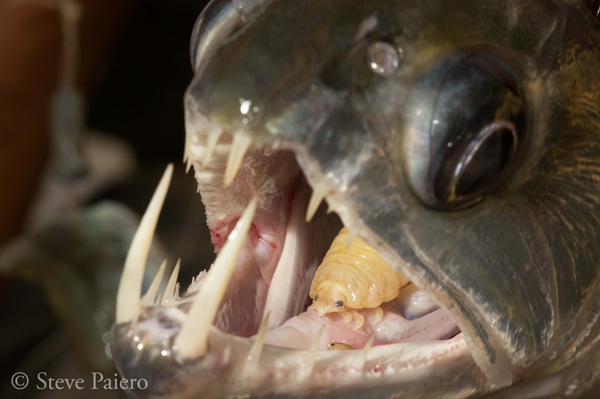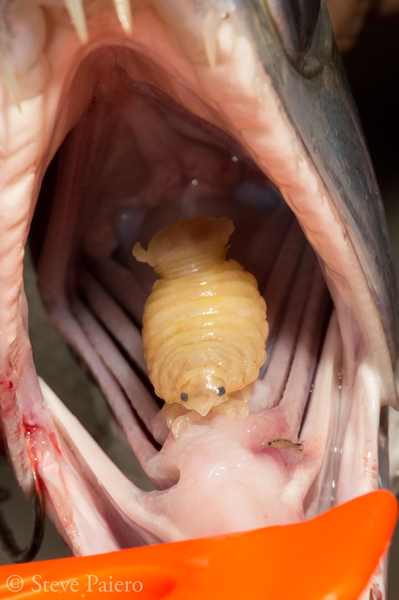Why, you might ask? Because of this:
Since a piranha-like fish with 1+ inch teeth isn’t scary enough on it’s own, this one has a frickin’ isopod for a tongue! Big sharp teeth, murky water, and a tongue-replacing parasite: need I say more?
This little beauty was fished from the depths by my labmate Steve Paiero while visiting Guyana in January. I can imagine reeling in this Hydrolycus (I think the fish is either Hyrdolycus armatus or Hydrolycus tatauia) would be exciting, but then to remove the hook and find a parasitic isopod looking back at you? Amazing. Or horrifying. I’m not sure.
Cymothoidae isopods1 are one of the stranger parasites out there, and have garnered considerable attention from other bloggers. After entering the fish’s mouth through the gills2, they begin to suck on the fish’s tongue, drawing all the blood from it. As the tongue withers and dies, the isopod takes its place, and helps itself to any food the fish may happen to ingest, making them an odd combination of parasite turned kleptoparasite!
I could find very little taxonomic or natural history information about these isopods, but there is apparently only 1 species of Cymothoid isopod with a penchant for tongue, Cymothoa exigua [Update: Dr. Alistair Dove (@para_sight) of the Georgia Aquarium informs me there are numerous tongue biting isopods. This is unsettling]. Oddly, all accounts I’ve been able to find list Cymothoa exigua as a marine species, and not something you’d expect to find hundreds of kilometers up a river in the mouth of a freshwater fish! Seeing as it has a few more legs than I’m used to dealing with, if someone has a better idea on what’s going on, I’d love to hear about it.
Needless to say, I’m glad I’m not a small guppy potentially staring this in the face one day!
UPDATE April 11, 2012: It seems there are a mouthful of tongue biting isopods in South American freshwater ecosystems. I’m in the process of doing a little more research and will update the identity and biology when I can!
___________________
1- That’s right, this beastie is a cousin of the innocuous little pill bugs (sometimes called potatoe or sow bugs) that you can find in your own backyard.
2- You can see another little isopod latched on to the right side of the mouth in both photos. Whether this is an immature Cymothoa exigua or a different species I’m not sure. Either way, tough luck for the fish!



Could be undescribed species. Seems sort of odd that you would find a marine fish parasite on a freshwater fish.
Also, you’d be fine swimming if you keep your mouth shut. 😉
That’s what I was thinking Kai, if they were insects I’d assume totally different species! We’ll have to look into it some more I think.
It looks so cute sitting in there! Quite the find, and great photos by Steve.
Steve did an awesome job on the photos. When he got back from the trip and was flipping through them, I flipped out over the series because they’re composed so perfectly!
I’m with Kai – undescribed species is a more likely explanation than dual marine/freshwater tolerance.
How horridly fantastic!
Agreed Ted (on both accounts). I think it warrants a little more digging to find the answer!
This makes me really happy to have opposable thumbs! Cool post!
Lol, thanks. I’m not sure how I missed your blog until now, but your photography is fantastic!
Hi Morgan,
Is that also a small fluke in the fishes mouth (bottom right).
Being this is now September 2012, this had to be the type of thing that the creator of the new movie “Possessed” came across for inspiration. Wow ! I will NEVER, NEVAH take a swim in
South American waters. Creepy to say the least.
But ofcourse you bug guys love this stuff. That’s a good thing.
Just a footnote, I was researching the Apocephalos Borealis Fly that is parasitically infecting
and destroying the Bee populations out in California when I ran across your friends photo and then your blog.
Great Information !!! Keep up the good work.
Smiles to you and not to the parasites,
Barbara
Thanks for stopping by Barbara. Yes, that’s another isopod hanging out in the fish’s mouth. The marine biologist I contacted about it (Dr. Alistair Dove of the Georgia Aquarium) suggested it may actually be a male of the same species as the tongue replacer!
The world of parasites is an amazing place!
Sorry. I vomited to the screen within 15 minutes afterr seeing and reading this. 8-P
The isopod is probably Braga patagonica. I would have to see specimens to be certain. Nothing that unusual about isopods infecting South American freshwater fishes. There are also a few in Africa and Asia.